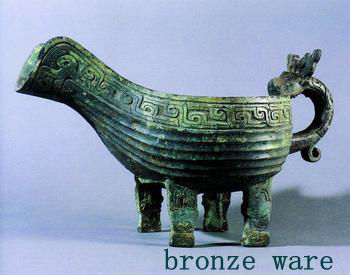- Copper: discovery and industry development
- Copper was one of the first metals to be discovered, and was also the first in history to be used by human beings.
- It is conjectured that the copper beads discovered in northern Iraq, which were made of native copper, had been in existence for more than 10,000 years.
 In ancient times, minable copper mineral resources were few, but copper could be easily extracted from its ore. In the 13th century, copper was extracted in Swedish falun: first, by baking sulfide ore, and then using water to isolate the copper sulfate; after flowing over the surface of iron filings, copper would precipitate. The copper layer could then be easily separated. Therefore, at that time, copper became the source of great wealth for Sweden.
In ancient times, minable copper mineral resources were few, but copper could be easily extracted from its ore. In the 13th century, copper was extracted in Swedish falun: first, by baking sulfide ore, and then using water to isolate the copper sulfate; after flowing over the surface of iron filings, copper would precipitate. The copper layer could then be easily separated. Therefore, at that time, copper became the source of great wealth for Sweden.- In China, another way of extracting copper was hydrometallurgy, which was one of the most important discoveries in the history of chemistry. Its chemical formula is: CuSO4+Fe=FeSO4+Cu.
 As artefacts made with copper were extremely soft, flexible, and easily became tarnished, people began dipping tin into copper to get copper-tin alloy — later called bronze — which greatly enhanced its hardness. As a material, bronze was easily fusible and cast, and was stable in the air, so it was widely used in ancient times. For instance, in around 280 BC, a bronze statue of Helios was shaped and stood, at the entrance to Rhodes harbour, on the Aegean island of Rhodes.
As artefacts made with copper were extremely soft, flexible, and easily became tarnished, people began dipping tin into copper to get copper-tin alloy — later called bronze — which greatly enhanced its hardness. As a material, bronze was easily fusible and cast, and was stable in the air, so it was widely used in ancient times. For instance, in around 280 BC, a bronze statue of Helios was shaped and stood, at the entrance to Rhodes harbour, on the Aegean island of Rhodes.
 In modern times, copper has been widely used in the electrical power and electronics industries. During the 1960s, the two industries accounted for 28% of copper consumption, and up until 1997, they remained the main fields of copper consumption, accounting for more than 25%. Later, copper was widely used in the electrical industry, light industry, machinery manufacturing, construction, transportation and other fields. The focus of the copper consumer market was moving from Western Europe and the United States, where it had been concentrated over the past 2000, towards China, Russia, India, Brazil and other developing countries.
In modern times, copper has been widely used in the electrical power and electronics industries. During the 1960s, the two industries accounted for 28% of copper consumption, and up until 1997, they remained the main fields of copper consumption, accounting for more than 25%. Later, copper was widely used in the electrical industry, light industry, machinery manufacturing, construction, transportation and other fields. The focus of the copper consumer market was moving from Western Europe and the United States, where it had been concentrated over the past 2000, towards China, Russia, India, Brazil and other developing countries.- As a result of the copper industry’s rapid development, the limited energy available for mining worldwide, and also the old copper quantities increasing, activity on the global copper supply market is intense and prices become ever higher. With its reliability, efficiency and performance, copper has been regarded as an integral part of sustainable energy initiatives. In some developed countries, its sustainability has accounted for 50% of its applications in the market.
-
About us
Contact us
Make a suggestion
- Metalpedia is a non-profit website, aiming to broaden metal knowledge and provide extensive reference database to users. It provides users reliable information and knowledge to the greatest extent. If there is any copyright violation, please notify us through our contact details to delete such infringement content promptly.
 In ancient times, minable copper mineral resources were few, but copper could be easily extracted from its ore. In the 13th century, copper was extracted in Swedish falun: first, by baking sulfide ore, and then using water to isolate the copper sulfate; after flowing over the surface of iron filings, copper would precipitate. The copper layer could then be easily separated. Therefore, at that time, copper became the source of great wealth for Sweden.
In ancient times, minable copper mineral resources were few, but copper could be easily extracted from its ore. In the 13th century, copper was extracted in Swedish falun: first, by baking sulfide ore, and then using water to isolate the copper sulfate; after flowing over the surface of iron filings, copper would precipitate. The copper layer could then be easily separated. Therefore, at that time, copper became the source of great wealth for Sweden. As artefacts made with copper were extremely soft, flexible, and easily became tarnished, people began dipping tin into copper to get copper-tin alloy — later called bronze — which greatly enhanced its hardness. As a material, bronze was easily fusible and cast, and was stable in the air, so it was widely used in ancient times. For instance, in around 280 BC, a bronze statue of Helios was shaped and stood, at the entrance to Rhodes harbour, on the Aegean island of Rhodes.
As artefacts made with copper were extremely soft, flexible, and easily became tarnished, people began dipping tin into copper to get copper-tin alloy — later called bronze — which greatly enhanced its hardness. As a material, bronze was easily fusible and cast, and was stable in the air, so it was widely used in ancient times. For instance, in around 280 BC, a bronze statue of Helios was shaped and stood, at the entrance to Rhodes harbour, on the Aegean island of Rhodes. In modern times, copper has been widely used in the electrical power and electronics industries. During the 1960s, the two industries accounted for 28% of copper consumption, and up until 1997, they remained the main fields of copper consumption, accounting for more than 25%. Later, copper was widely used in the electrical industry, light industry, machinery manufacturing, construction, transportation and other fields. The focus of the copper consumer market was moving from Western Europe and the United States, where it had been concentrated over the past 2000, towards China, Russia, India, Brazil and other developing countries.
In modern times, copper has been widely used in the electrical power and electronics industries. During the 1960s, the two industries accounted for 28% of copper consumption, and up until 1997, they remained the main fields of copper consumption, accounting for more than 25%. Later, copper was widely used in the electrical industry, light industry, machinery manufacturing, construction, transportation and other fields. The focus of the copper consumer market was moving from Western Europe and the United States, where it had been concentrated over the past 2000, towards China, Russia, India, Brazil and other developing countries.